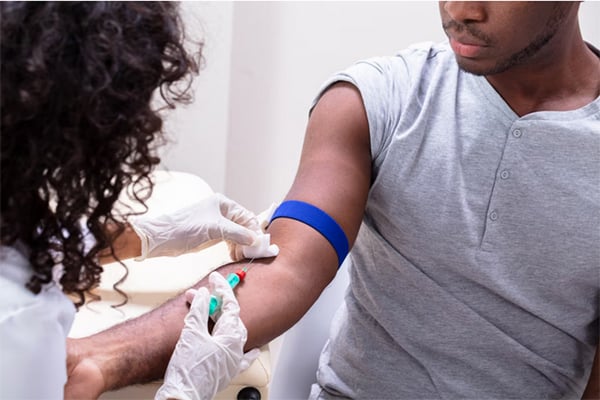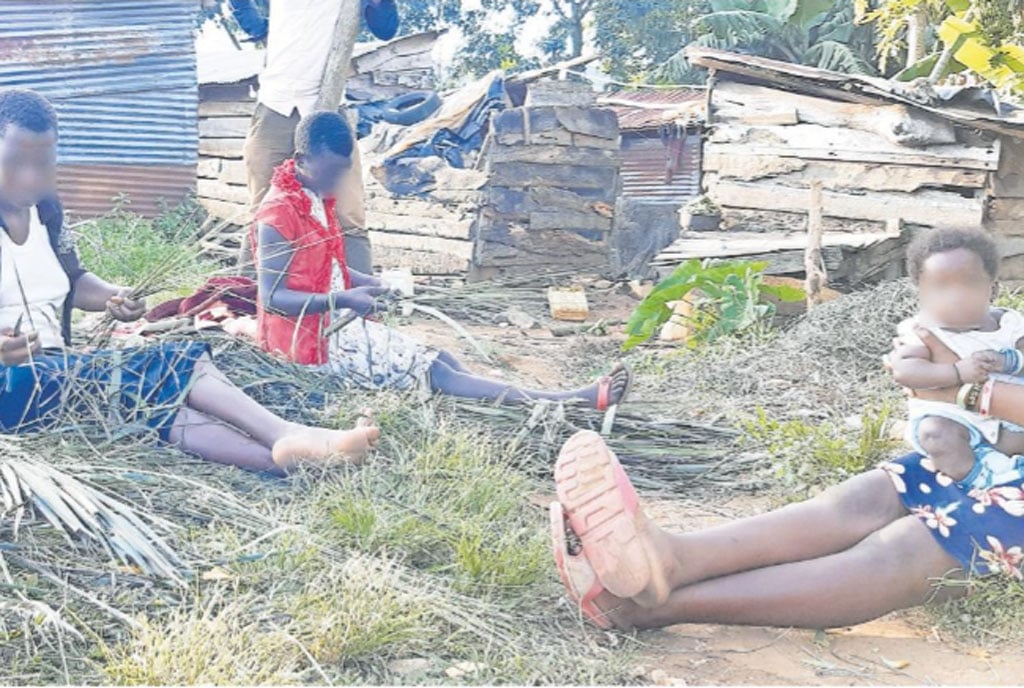Prime
Ravages of Hepatitis B

The first step is to get tested for Hepatitis so that if you are found to be positive medical assistance and treatment is given early to avoid complications. PHOTO | COURTESY
What you need to know:
- Eight out of every 10 Ugandans who contracted Hepatitis B over the past five years were aged 20-59.
The viral Hepatitis B disease that causes inflammation of the liver is crippling the most productive Ugandans, according to our analysis of official government data.
Details in the Health Management Information System (HMIS), the Health ministry’s central data portal, shows that eight out of every 10 Ugandans who contracted Hepatitis B over the past five years were aged 20-59. This demographics constitutes the skilled and experienced labour force in the country, meaning those infected or killed by the disease are young adults or those in prime of their lives who double as providers for loved ones.
At roughly 10 percent, children and teenagers --- who, according to the latest census figures, constitute half of the Ugandan population – are the second least affected while only six percent of senior citizens aged 60 or older live with the disease.
Hepatitis B has killed at least 728 of 79,597 infected Ugandans from January 2020 to mid this year, an annual average fatality rate of 1 percent. The highest number of Hepatitis B patients died in the country in 2022 - some 242 - and officials could not explain the reason for the observed spike. Far fewer Ugandans succumbed to the disease in 2021, the year of Covid-19 pandemic.
It is unclear how comprehensive or accurate the national data pooled from districts’ entries are.
According to the World Health Organisation (WHO), up to 6 percent of Ugandans, or 2.8 million, suffer chronic Hepatitis infection, but it does not detail how many of these are Hepatatis B cases. Neither the global health watchdog nor the government was available to render a deeper explanation on what on the face of it appears wide disparity in infection and fatality statistics.
We did not get statistics on prevalence by demographics and distribution by region of other strains of Hepatitis to provide a comprehensive and complete picture of the disease’s burden.
Hepatitis has five main strains – A, B, C, D and E – and, according to WHO, it transmits through blood and bodily fluids – most commonly unprotected sex.
One official speaking on condition of anonymity for lack of authority to speak on the matter, said the higher prevalence of Hepatitis B among Ugandans in the 20-59 age bracket may suggest they are the most sexually active group.
Although every Hepatitis strain causes liver disease, the B and C types lead to chronic maladies in “hundreds of millions of people and, together, are the most common cause of liver cirrhosis, liver cancer and viral hepatitis-related deaths”, according to WHO.
Our analysis shows that the highest burden of Hepatitis B year-on-year is registered in Kampala, the Ugandan capital which has the largest daily transient population in the country.
For instance, over the past four-and-a-half years, the city registered nearly 10,000 confirmed Hepatitis B cases, nearly triple the second placed Ankole Sub-region, which has a total 3,738 cases.
At 3,374 cases, north central (Buganda) ranks third with Acholi (2,510) following and Tooro and south central (Buganda) in 5 and 6th positions, respectively.
In the 7th, 8th, 9th and 10th slots are Karamoja, West Nile, Bunyoro and Busoga sub-regions while Bukedi and Teso had correspondingly lower cases.
With only 216 confirmed Hepatitis B infections since 2020, Kigezi Sub-region has the least prevalence in the country.
The persistence of the disease – in fact notably a rise in infections from 2022 – fly in the face of a continuous immunisation of mainly girls of potentially child-bearing age under a government-directed campaign.
Dr Daniel Okello, the director of Public Health and Environment at Kampala Capital City Authority (KCCA, said many of the cases in the city resulting in higher numbers in the Health ministry portal are referrals from upcountry.
The reason? Better equipped health facilities and more specialised medical care in the capital, he argued.
“All that high number of Hepatitis B patients [registered in Kampala] do not necessarily mean that they are from Kampala,” Dr Okello said.
Mr Kenneth Kabagambe, the executive director of The National Organisation for People Living with Hepatitis B (NOPLHB), critiqued the government for domiciling response to Hepatitis under immunisation rather than curative care.
He told this newspaper that there is chronic stock-out of medicines and, in desperation, some of the Hepatitis patients are put on Anti-Retroviral therapy (ARVs) meant for persons living with HIV/Aids – claims he repeated during an August 16 press conference.
“Access to proper medication is not just a matter of convenience; it is a matter of survival. The current shortage of Hepatitis B medicines in public health facilities has forced many patients to use combined HIV drugs as an alternative,” Mr Kabagambe told the media briefing.
He added: “While we acknowledge the importance of antiretroviral therapy for HIV [treatment], we must emphasise that these drugs are not designed to treat Hepatitis B in isolation and may lead to severe complications for those who rely on them for this purpose [treatment and recovery.”
Some 1.8 million Ugandans live with Hepatitis B, he noted, a figure oddly at variance with that of both the Health ministry and WHO.
We could not independently verify these accounts after senior medical doctors in public service and private practice we reached out to, declined to discuss the matter.
Dr Diana Atwine, the permanent secretary in the Ministry of Health, without speaking to the alleged use of ARVs to treat Hepatitis B patients, acknowledged drug stock-outs for the disease that she said “is not curable”.
“But you can modify its progress[ion] on the liver by [starting to take] the medicines early, by monitoring the function of the liver, by doing tests and the start of treatment,” she said, “It’s true the medicine may not be enough. We want to talk about integrated approach, we don’t one to treat Hepatitis as if it is standing alone; we want to look at a comprehensive care.”
The PS added: “If the medicine is not there, tomorrow the case will not be the same throughout. Hepatitis is like any other disease, we get shortage in medication, but it [shortage] is not permanent. We can run out of medicine today, but the medicines will be there tomorrow. What we encourage people [to do] is to seek care because it’s through that, that you get advice … you get medicine, and … [and] you get checked up.”
Mr Lutamaguzi Emmanuel, the executive director of Hepatitis Aid Organisation, proclaimed that “it is time for action, Hepatitis can’t wait,” suggesting accelerated public awareness campaigns about the disease, capacity building, research, innovation, intensified resource mobilisation an strengthening service delivery mechanisms. He also proposed increased tracing of Hepatitis patients, their linkage to care and retention on treatment, building transformative partnerships to “build an inclusive multi-sectoral response and engaging in community-focused interventions [for] an impactful response that is embraced by all”.
The government is not sitting on its laurels about the disease, State Minister for Health (General Duties) Anifa Kawooya said in a rejoinder, referring to a comprehensive package included in the Health National Viral Hepatitis Prevention and Control Strategic Plan 2023 – 2028 that she launched in the eastern Kumi District on August 2, 2024.
“The cause [of Hepatitis infection] is really preventable; either contact with body fluids such as saliva or unprotected sex with an infected person or too much alcohol,” she said.
She disclosed that the government plans to bolster immunisation against Hepatitis in northern Uganda - due to risk of cross-border infections from neighbouring South Sudan – before accelerating the exercise elsewhere in the country.
Themed “Action now”, the Health ministry’s blueprint on Hepatitis prioritises prevention, advocacy, treatment, and vaccination against Hepatitis B.
In a separate interview, Dr Doreen Ruth Akuno of the Uganda National Expanded Programme on Immunisation (UNEPI), said they jab new-born babies within 24 hours “so that if they are born with Hepatitis B, their infection is prevented”.
She asked traditional birth attendants and those who conduct circumcision during cultural rites such as Imbalu to sterilise and not share the knives and razor blades that they use.
“Hepatitis B virus can remain on the floor active for three days. If we say we are only washing those knives and we are continuing with the circumcision, the rest of the people are not safe,” Dr Akuno added.
Region 2020 2021 2022 2023 2024_by June TOTAL
Acholi 623 482 407 553 436 2,501
Ankole 271 339 959 1,231 838 3,638
Bugisu 194 14 49 161 43 461
Bukedi 117 23 46 227 262 675
Bunyoro 555 241 191 202 125 1,314
Busoga 275 268 143 404 115 1,205
Kampala 1,078 2,150 3,358 1,871 1,392 9,849
Karamoja 325 331 467 670 431 2,224
Kigezi 74 63 21 49 9 216
Lango 112 60 94 101 151 518
North Central 1,117 459 696 525 577 3,374
South Central 220 406 498 1,003 266 2,393
Teso 168 99 72 109 119 567
Tooro 1,252 408 319 291 128 2,398
West Nile 545 400 479 453 210 2,087
Total 6,926 5,743 7,799 7,850 5,102 33,420




